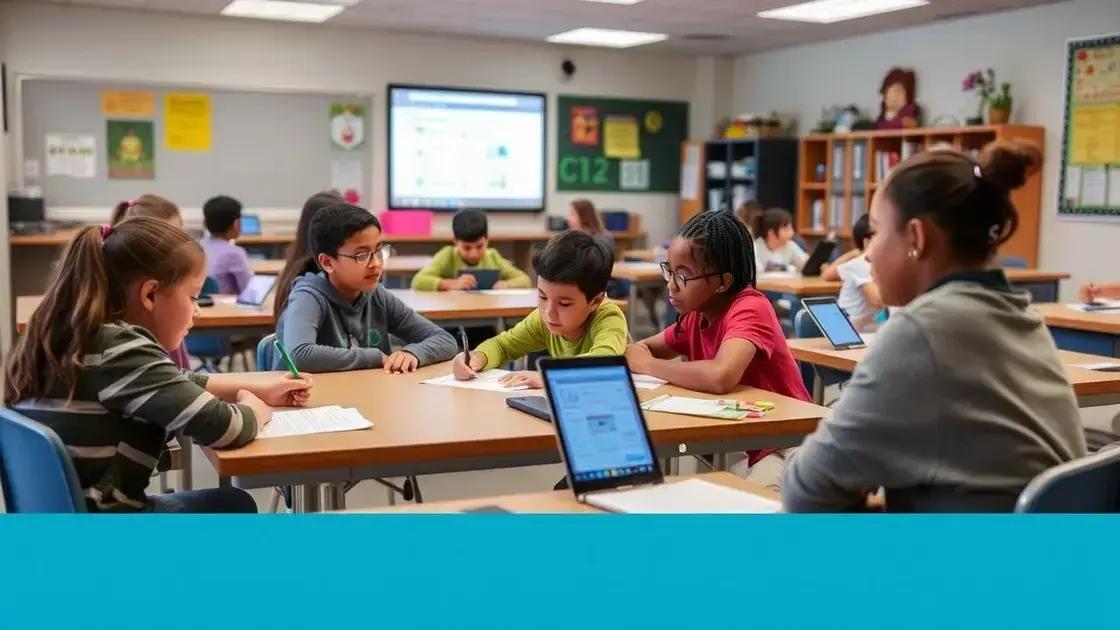Teacher workforce challenges and tariff exemptions explained

Anúncios
The future outlook for teacher retention and support emphasizes the importance of community engagement, professional development, and strong mentorship programs to create a stable teaching workforce and enhance student learning experiences.
Teacher workforce challenges are more complex than you might think. With changing policies like Trump’s tariff exemptions, it’s essential to understand their effects on education.
Anúncios
Understanding the teacher workforce landscape
Understanding the teacher workforce landscape is essential for addressing current educational challenges. Teachers play a vital role in shaping young minds, yet they face various issues that impact the quality of education.
Key Factors Influencing the Teacher Workforce
Several elements come into play when we examine the landscape of the teacher workforce. These factors contribute to both the challenges and opportunities within the profession. It’s important to recognize these elements to provide adequate solutions for educators.
Anúncios
- Teacher shortages in various regions affect student learning.
- Workload and stress levels impact teacher retention.
- Diversity in the workforce supports inclusive education.
- Professional development opportunities enhance teacher skills.
Moreover, many teachers experience burnout due to various demands. This challenge is exacerbated by low salaries and increased expectations. When teachers feel overwhelmed, their ability to deliver quality education diminishes.
Understanding Teacher Retention
Retention of educators is crucial for maintaining a stable learning environment. By prioritizing factors that enhance job satisfaction, we can help reduce turnover rates. Factors contributing to retention include positive working conditions, administrative support, and professional growth paths.
The impact of administrative support should not be overlooked. When teachers know that they have backing from their schools, they feel more confident in their roles. This assurance encourages them to stay longer in the profession and positively influences their students’ success.
Additionally, understanding how tariff exemptions and educational funding relate to the teacher landscape is essential. These aspects can shape policies that ultimately determine how schools operate and the resources available for educators.
Challenges in Different Regions
Different regions face unique challenges in building and maintaining a proficient teaching workforce. Rural areas, for instance, often struggle with attracting qualified professionals, whereas urban centers may deal with high turnover rates.
To effectively tackle these challenges, schools must adopt targeted strategies tailored to their specific needs. This might include offering incentives to attract educators or creating supportive communities that foster teacher growth and development.
Key challenges faced by educators today
Today, educators face numerous challenges that impact their ability to teach effectively. Understanding these obstacles is crucial for developing solutions that can improve the educational landscape.
Overcoming Teacher Shortages
One of the most pressing issues is the teacher shortages experienced in many regions. This shortage compromises the quality of education students receive. Schools often struggle to find qualified instructors, which leads to larger class sizes and increased workloads for those who remain.
- Recruitment efforts must be increased to attract new talent.
- Providing competitive salaries can make the profession more appealing.
- Alternative pathways to certification can help fill gaps.
Additionally, retaining existing teachers is essential for maintaining a stable workforce. Many educators leave the profession due to burnout and stress, which can stem from overwhelming duties and insufficient support.
Addressing Workload and Burnout
The workload educators face has significantly increased in recent years. Responsibilities now include administrative tasks, lesson planning, and communication with parents. These added demands can lead to fatigue and decrease their effectiveness in the classroom.
To tackle burnout, schools need to prioritize well-being initiatives. Providing resources for mental health support can help teachers manage stress better. Creating a collaborative environment where they feel valued can also boost morale and retention.
Furthermore, educators often feel isolated in their roles. Establishing a strong community among teachers can create a support network that encourages sharing of resources and strategies. This camaraderie aids in overcoming daily challenges and fosters a positive work environment.
Coping with Budget Constraints
Many educators deal with the reality of budget cuts, which severely limits resources for teaching. When schools face budget constraints, teachers often have to spend their own money on supplies or materials needed for their classrooms.
Advocacy for better funding is essential for ensuring that schools can provide the necessary resources. Engaging in discussions with local policymakers can help shed light on the challenges faced by teachers and the impact on students. By emphasizing the need for adequate funding, educators can work towards solutions that benefit everyone involved in the educational process.
Impact of tariffs on education technology

The impact of tariffs on education technology is significant, especially in today’s digital-driven learning environment. Tariffs can increase the costs of essential educational tools, hindering schools’ ability to provide the latest technology to students.
Understanding Tariffs
Tariffs are taxes applied to imported goods. When tariffs are imposed on technology products, like computers and software from overseas, prices rise. This increase means schools may have less funding available for other critical areas, such as hiring more teachers or developing programs.
- Higher costs limit access to modern technology.
- Schools may fall behind in terms of educational resources.
- Budget constraints can impact student learning experiences.
Furthermore, schools in low-income areas often feel the effects of these tariffs more acutely. Limited budgets mean they struggle even more to acquire necessary tools for effective teaching. Without up-to-date technology, these schools cannot prepare students for a technology-rich workforce.
The Broader Implications for Education
Increased costs from tariffs can lead to a reliance on outdated technology. This situation reduces the quality of education and can affect student outcomes. Schools may also find it difficult to adopt innovative teaching methods that require advanced technological tools.
Consider how remote learning has become vital. Many students now learn from home, relying heavily on technology. If schools cannot afford the tools needed, students miss out on important learning opportunities. This gap creates disparities in education quality across different regions.
Additionally, the effects of tariffs can extend beyond the classroom. They can influence the job market for future graduates. If students lack access to technology, they might not develop needed skills, making it challenging to compete in the workforce after graduation.
Navigating budget constraints and resources
Navigating budget constraints is a significant challenge for many educational institutions today. Schools often find themselves managing limited resources while trying to deliver quality education.
Understanding Budgeting in Education
Fund allocation within schools determines what resources are available. A well-structured budget ensures that teachers have the tools they need to succeed. Unfortunately, many districts face tight budgets that force them to prioritize certain aspects of education over others.
- Essential supplies may be underfunded.
- Technology upgrades could be delayed due to cost.
- Teacher salaries might not keep pace with inflation.
When budgets are cut, teachers often feel the pinch first. This can lead to larger class sizes and fewer materials, which directly impacts student learning. Educators must find innovative ways to stretch their budgets and maximize resources available to them.
Strategies for Maximizing Resources
One effective way to navigate these constraints is through community partnerships. Collaborating with local businesses can provide additional support and resources. Schools can also seek grants and funding from nonprofits dedicated to improving education. This can help fill gaps in their budgets.
In addition, schools can implement resource-sharing programs, where they collaborate with nearby districts or schools to share equipment and materials. This cooperative approach can alleviate some financial burden.
Effective communication with stakeholders is key as well. By explaining the financial needs and challenges facing the school, educators can foster community support. Engaging parents and local businesses in fundraising efforts can also enhance available resources.
Lastly, utilizing technology can assist in navigating budget constraints. Online platforms for educational resources can provide teachers with cost-effective alternatives for lesson plans and student engagement. By embracing innovative solutions, schools can continue to provide quality education, even within budget limitations.
Future outlook for teacher retention and support
The future outlook for teacher retention and support is critical for enhancing the educational landscape. As challenges persist, understanding how to improve retention remains a top priority for school administrators and policymakers.
Importance of Teacher Retention
Retaining skilled teachers is essential for providing students with consistent and high-quality education. When teachers stay in their positions longer, they build strong relationships with students and contribute to a stable learning environment. This consistency promotes better student outcomes and enhances school culture.
- Strong teacher-student relationships lead to improved academic performance.
- Experienced teachers can better support new educators.
- Retention reduces the costs associated with hiring and training new staff.
To improve retention, it’s essential to understand what factors encourage teachers to stay in their roles. Salary, professional development opportunities, and administrative support play crucial roles in job satisfaction.
Strategies for Supporting Teachers
Providing adequate support is key to addressing retention issues. Incentive programs can boost morale and reward teacher commitment. Schools should consider offering bonus structures or pathways for career advancement.
Moreover, mentoring programs can help new teachers acclimate to their roles. When experienced educators partner with newcomers, it fosters a sense of community and shared knowledge. This collaboration encourages longevity in the profession and improves teaching practices across the board.
In addition, ongoing professional development opportunities allow teachers to refine their skills and adapt to changing educational needs. Schools can organize workshops and training sessions that cater to teachers’ interests, enhancing their engagement and investment in their work.
The Role of Community and Collaboration
Partnering with families and the local community creates a robust support system for teachers. Schools can engage parents in the educational process, encouraging them to advocate for their children’s teachers.
When teachers feel valued by their communities, they are more likely to stay in their positions. Open lines of communication between educators, families, and administrators help build trust and foster collaboration.
Ultimately, the future of teacher retention depends on a shared commitment to supporting educators. Schools must prioritize the needs of teachers and create an environment where they can thrive.
In conclusion, addressing the challenges facing the teacher workforce is vital for the future of education. By focusing on retention and support, schools can create an environment where educators feel valued and inspired. Effective strategies that promote collaboration, community engagement, and professional development are essential for fostering a healthy teaching landscape. Prioritizing these elements will not only benefit teachers but also enhance student learning experiences.





